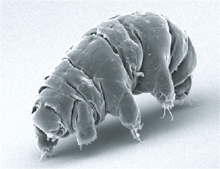Tardigrade
The tardigrades (Tardigrada), commonly called water bears due to their appearance and movements, constitute a phylum of ecdysozoans within the kingdom animal, characterized by being invertebrates, protostomes, segmented and microscopic (500 µm on average). They are also grouped within the large group of panarthropods because they present characters that suggest that they share a common ancestor with arthropods, along with onychophorans.
They were first described by Johann August Ephraim Goeze in 1773, who named them «water bears» (from the German Kleine Wasser-Bären, literally 'little water bears') and refers to to the way they walk, similar to the gait of a bear. Later, the term "tardigrade" (meaning 'slow-paced') was given by Lazzaro Spallanzani in 1777, precisely because of the slowness of this animal.
They are extremophile organisms (resistant to extreme conditions), with unique characteristics in the animal kingdom such as being able to survive in the vacuum of space or withstand very high pressures of almost 6000 atm; they can survive temperatures of -200 °C and up 150 °C, to prolonged dehydration (they can go up to 10 years without obtaining water) or to ionizing radiation.
General characteristics
Most tardigrades are terrestrial and inhabit mainly mosses, lichens or ferns, although they can also inhabit oceanic or freshwater waters, there being no corner of the world that they do not inhabit. The largest adult specimens can be seen with the naked eye because they reach a length of 0.5 mm on average, however, the smallest can measure only 0.05 mm.
They are oval or elongated in shape, can enter cryptobiosis (reduced metabolism) and feed by sucking plant or animal liquids. In addition to having eukaryotic cells, they have a non-chitinous cuticle, although they can moult. More than 1,000 species of tardigrades are known. Some authors still consider them a class of arthropods.
Tardigrades are made up of around 1,000 cells and some species are eutelic, that is, they keep the number of cells constant during their development. However, according to other sources, the number of cells is around 40,000.
Some tardigrades lay their eggs while shedding their cuticle (external covering), in such a way that the clutch remains lodged in the cuticle from which they have just shed, which will serve as protection.
Structure
Endowed with bilateral symmetry, with a flattened ventral area and a convex dorsal area, tardigrades consist of five undifferentiated segments. A poorly differentiated, blunt-shaped head segment containing the mouth (with a pair of internal stylets) and sometimes eyespots or eyespots and sensory cirri. The remaining four segments each have a pair of clawed (four to eight) or sucker-terminated ventrolateral legs; normally the first three pairs are used for locomotion while the fourth is used to anchor to the substrate since tardigrades are extremely light and even a light breeze can easily drag them. The outer non-chitinous cuticle that covers them can be of a great variety of colors. Tardigrades are oviparous, dioecious, and undergo direct development, without larval stages. They lack circulatory and respiratory systems, but they do have nervous, excretory and reproductive systems. They have cells (matoxystems)[citation required] that allow them to survive in any environment be it water, air, vacuum, etc.
Digestive system
The highlight of the digestive system is its oral structure. It is characterized by a mouth opening or proboscis formed by three rings of cuticle embedded towards the interior cavity, which continues with a tubular pharynx and then a sucker, in which there are powerful circular muscles that make sucking movements. In this musculature there are sclerotized structures called macroplacoids, which give rigidity to the structure and also represent an insertion point for the sucking muscles. The structure of the mouth is associated with two sharp stylets that are associated with retractor and protractor muscles. Its function is to go through the walls of the plants on which it feeds and suck the photosynthates. The resting stylets are embedded in the salivary glands, which are in charge of secreting them again, along with the rest of the oral structure, after ecdysis (molting process).
Tardigrades feed on bacteria, algae, cryptogams, rotifers, nematodes, and other microscopic invertebrates. They normally slurp up its cells but occasionally ingest the whole organisms.
Resistance to extreme conditions
Cryptobiosis
Perhaps the most fascinating quality of tardigrades is their resilience and ability, in extreme environmental situations, to enter a state of suspended animation known as cryptobiosis or anhydrobiotic state. Through a process of dehydration, they can go from having the usual 85% body water to only 3%. In this state, growth, reproduction, and metabolism are reduced or temporarily ceased, and thus can take up to 4.4 years. frozen years.
This resistance enables tardigrades to survive seasons of extreme cold and dryness, radioresistance to ionizing radiation, and resistance to heat and pollution. There are studies that show that, in a state of undetectable metabolism, they can survive temperatures ranging between -20 °C and 100 °C. In extreme laboratory conditions it seems that they can survive temperatures between -273 °C, almost absolute zero, and 151 °C. It is also indicated that they can survive immersion in pure alcohol and ether. Russian scientists claim to have found live tardigrades on the decks of rockets recently returned from outer space. Recent research shows that they are capable of surviving in outer space.
In 1948, the Italian biologist Tina Franceschi rehydrated some tardigrades from a dried moss sample, kept in a museum since 1828. After twelve days, one of the specimens showed some slight signs of movement, then nothing. Franceschi's observations were greatly exaggerated in subsequent citations, stating in numerous works, although without any real foundation, that tardigrades can revive after spending 120 years in a state of cryptobiosis.
Spatial exposure
In September 2007, the Russian/ESA Foton M3 space probe was launched, and a group of tardigrades was placed on it. It was found that they not only survived the conditions of outer space, but even maintained their reproductive capacity, which is why they are considered the most resistant living being. In addition, they can withstand 100 times more radiation than the most resistant living things and can spend years in a hibernation state without water, reactivating as soon as it is supplied.
Ultraviolet radiation
In October 2020, researchers from the Indian Institute of Sciences (Bangalore) discovered a new species of the genus Paramacrobiotus that has fluorescent pigments that protect it from ultraviolet radiation. By extracting the fluorescent pigments, scientists have been able to protect nematodes and other tardigrades that do not possess these pigments from ultraviolet light, demonstrating for the first time that fluorescence has a protective function in some species.
Phylogeny and systematics
The tardigrade phylum consists of three classes: heterotardigrades, eutardigrades, and mesotardigrades, although the latter taxon is based only on a description of the species Thermozodium esakii (Rahn, 1937) from a spring Japanese hot water near Nagasaki. The specimens and the spring were destroyed by an earthquake so the class and species is doubtful (nomen dubium).
The phylogenetic relationships of tardigrades are unclear. Sometimes considered a pseudocoelomate phylum, or members of a group called Pararthropoda (a group that also included the onychophorans and which has been shown to be paraphyletic), the current trend is to place them together with onychophorans and arthropods in a clade called Panarthropoda within from Ecdysozoa, some recent phylogenies considered them closer to nematodes than to onychophorans and arthropods; however this phylogeny is now believed to be a consequence of long branch attraction. According to molecular analyses, they constitute the first divergent group of the Panarthropoda clade.
Contenido relacionado
Natural Sciences
Posidoniaceae
Calathea




